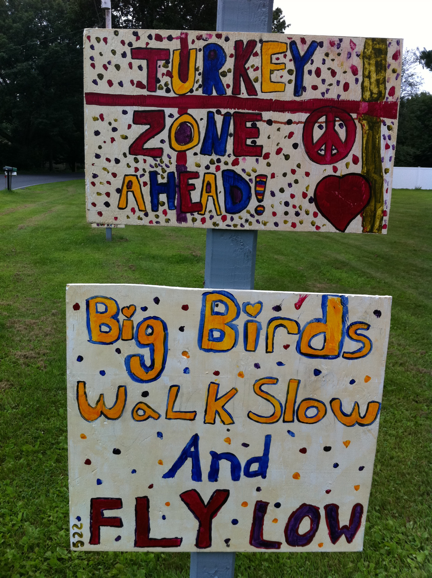a series of fragments & notes about Chance, Fate, and Context by Dara Wier
When one passes along roadways and streets and lanes and sidewalks, one comes across now and then hand-lettered signs that say FREE.
Usually beside or around or behind or in front of these signs there are a few things someone wants to be rid of.
Some time ago, I don’t remember when exactly, I decided to take these signs literally, not literally. Since then I’ve been collecting photos of an assortment of these hand-painted signs. I think by now I have maybe a couple or three dozen of these, ranging in size from about as big as a car’s license plate to about as big as half a sheet of standard cut plywood.
Many of them are plywood. A few are made of tough cardboard. One is sheetmetal (16″h x 40″w), its paint is tomahawk red and flaking. Most of them are FREE in black or blue paint, with no embellishments otherwise. All of them are free style hand printed, non-standard, idiosyncratic: FREE they all say, that’s all they usually say.
I’m writing this the day before one of our recurring national celebrations comes around. Already there are reports, literal reports, of explosions off in the distance. A little bit of jumping the gun, a little bit of practice with fireworks. Once it’s dark tomorrow the explosions will begin in earnest, and there will be a gradual building up to a fine grand finale of explosions and, if I’m nearby, and the weather’s co-operating, and I remember to watch, some kinds of fantastic re-enactments of stellar confabulations, conflagrations.
I will like it. By which I mean I will take in these gaudy, prismatic, violent, symmetrical, flaming, precise displays, and think it is all mysteriously fascinating. And a sort of caricature of what’s sometimes going on in my brain.
~~~~~~~~~~~~~~~~~~~~~~~~~~~~~~~~~~~~~~
Some of those whose life work involves direct and indirect, literal and analogical, study of our brains–their work is to watch how we work. Memory & mating are two of their favorite subjects. Since the mid 1980s there have been studies of what those who study it call transactive memory. This is the memory we share with others, various versions of collective memory. Storage. Capacity. A couple might share this, a family, a band, a brotherhood, a congregation, a litter, a swarm, a mob, a colony, a lounge, a location, a political aggregate, a herd, a household, a corporation, a club, a pack, a society, an order, a murder, a school, a pandemonion, a bed, a nest, a den, a flock. A timeframe: a minute, a day, a night, a season, a year, a decade, a quarter of a century, an era, a period, an age, a generation.
The Social Fabric
The social fabric The social fabric
as it hangs as it hangs
with the help with the help
of nine old-fashioned of nine old-fashioned
pine & wire pine & wire
clothespins clothespins
as it does now as it now does
on a plain length on a plain length
of cotton rope of cotton rope
strung between strung between
two trees two trees
north of our house north of our house
is holding up is holding up
alarmingly well. alarmingly well.
Often when it’s raining, I wonder from how high up is this water that’s soaking me to the bone falling. Sometimes I’d like to know.
Why? Because I guess I know someone somewhere can and maybe does know and he or she could tell me. And they never do. I’ve yet to meet the weather report that let’s me in on this secret.
I doubt it has anything to do with national security.
FREE signs never say this much. (I would never collect (steal?) a sign such as this one. (this sign could easily be interpreted (translation necessary) as some kind of secret sign directed toward someone who can decipher its secret message) Collecting and stealing, hoarding and protecting, accumulating and eroding, building up and tearing down,
(though I have loved Big Bird, how can one not?)
My First Day Without You.
That’s literal.
As is
My First Day With You.
How we take what is literal as rock bottom always metaphorical. How not to disperse these two as though they were otherwise not the same.
~~~~~~~~~~~~~~~~~~~~~~
Memory as collection. Collecting in memory. Cluttered up memory collections.
Memory collects and stores in arranged depositories such complex material one should always be shaking with awe over our capacity for memory.
And capacity seems especially telling. What’s your memory’s capacity? By what means can that be measured?
I spent some time this past week with someone who several times admitted that he has a really good memory. Sometimes he seemed almost alarmed by this understanding.
And I spent some time with people who were in various stages of reminiscing about some shared, some over-lapping, some adjacent experiences. It made me feel as if I were some kind of spectre, lacking substance, lacking the required net of memory to catch and hold so much detail. I loved the listening and did not regret my lack of recall. In fact, I liked the sensation of feeling something begin to come back to me. It seemed very much to allow me to feel things in my brain coalescing and joining in a series of recoveries from distant corners.
Much as what happens when disparate (well not really, I just thought so) sounds, signals, signs, words, syntax, images, phrases, half toned ideas, half or quarter or barely a sliver of an inkling, a piece of something, join up with a part of something else and suddenly there is something, really something.
I know they say that the farther away from one another two pieces of thought come to join one another, the more likely their potential sudden combination might produce something, another sensation, of revelatory impression. It feels just like a sudden awakening. And those are so strange because then they always feel as if one’s known this all along. And that’s where eternity and timelessness and unraveled and raveled walk in the door.
I just found this: It’s in a review of Heather Christle’s new book THE TREES THE TREES:
Christle’s poems use techniques more akin to those of landscape painting than the typical, confessional quasi-portraiture of her generation—both presenting and representing the more playful world beyond the laborious myth of artist-as-externalizer of majestic inner states. Instead, these poems “launch sideways,” parallel to the world, not out of it or at it, with Christle’s signature bright devotion.
The part I’m most struck by is “laborious myth of artist-as-externalizer of majestic inner states.” And the part I really like is ‘launch sideways.’
_______________________________________________________
Dara Wier is the author of eleven books of poetry, including Selected Poems, Remnants of Hannah, Reverse Rapture, and Hat on a Pond. She teaches in the University of Massachusetts MFA Program for Poets and Writers. Her awards include the Poetry Center and Archives Book of the Year Award, a Pushcart Prize, theAmerican Poetry Review’s Jerome Shestack Prize, and fellowships from the National Endowment for the Arts and the Guggenheim Foundation. She edits Factory Hollow Press. Visit her author page at Wave Books or read an interview.




